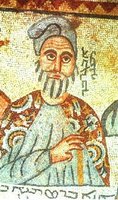Epstein dr.
 2008.04.21 2008.04.21
|
|
0 0
6049
|
  VI. Abgar osroenei király (71–91) egy edesszai mozaikképen VI. Abgar osroenei király (71–91) egy edesszai mozaikképen
The name under which Edessa figures in cuneiform inscriptions is unknown. In early Greek texts, the city is called Ορρα or Ορροα, transliterated Orrha or Orrhoa respectively, as the capital of the Kingdom of Osroe, named after its legendary founder Osroe, the Armenian form for Chosroes. The later native name was Edessa, which became in Syriac ܐܘܪܗܝ, transliterated Orhāy or Ourhoï, in Armenian it is Ուռհա , transliterated Urha or Ourha, in Arabic it is الرُّهَا, transliterated as Er Roha or Ar-Ruha, commonly Orfa, Turkish Urfa, Ourfa, Sanli Urfa, or Şanlıurfa ("Glorious Urfa"), its present name. Due to similarity of names, folk mythology in Islam connects Edessa with Ur as the abode of Abraham. Seleucus I Nicator, when he refounded the town as a military colony in 303 BC, mixing Greeks with its eastern population, called it Edessa, in memory of Edessa the ancient capital of Macedon. The name is also recorded as Callirrhoe, and under Antiochus IV Epiphanes the town was called Antiochia on the Callirhoe (Greek: Αντιόχεια η επί Καλλιρρόης) by colonists from Syrian Antioch (modern Antakya, Turkey) who had settled there. During Byzantine rule it was named Justinopolis. Its Kurdish name is Riha. |
Előzmény: Epstein dr. (6026)
|
|